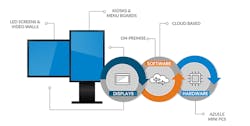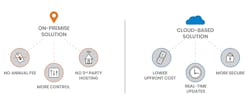Restaurant menus, airports, hospitals, businesses: Communication via digital screen is all around us—and the technology is only getting smarter. With an estimated 270 million Americans viewing their smartphones about 14 billion times per day, digital displays continue to prove their worth as consumers become ever more accustomed to receiving messages via device screens with instant access to information. Not only that, but the advantages of digital signage over traditional signage include improved ROI, flexibility, and data collection.
For example, Volvo on “Auto Row” in New York City stood out from its competitors by using a video wall to draw in people from the street. Digital signage is now going beyond by using touch— interactive digital signage has the potential to go beyond engagement into the realm of immersion. Interaction turns passive consumers viewing messages into active participants in an experience.
This robust technology has a bright future ahead—haptic technology, AI, holographic screens, and most importantly, cheaper technology for broader deployment. Digital signage can now be configured to fit the needs of any space, and this freedom allows companies to create custom and unique digital signage that fits anywhere. Companies should plan to get ahead of deployment today to take advantage as the new technology advances become pervasive and while it’s offered more affordably.
What is Digital Signage?
Digital signage consists of three basic components: display, software, and hardware. The displays can consist of LCD screens, electronic billboards, menu boards, projection screens, video walls, kiosks, and many more—this is where consumers will be viewing the content (Fig. 1).
1. Digital-signage software, also known as a content management system, is leveraged to create, manage, and deploy the content shown on the displays.
Digital-signage software, also known as a content management system (CMS), is used to create, manage, and deploy the content shown on the displays. CMS software allows businesses to schedule, customize, and even use video-editing software for their content. If the software being used is web-based, content can be created and changed remotely. The last component is the hardware, which is responsible for distributing and displaying the content. With the right hardware, content will playback seamlessly and uninterrupted.
For a broader description, digital signage consists of any size screen displaying any type of content for any reason. The potential of this modern display hardware is limited only by creativity and imagination. The technology is there to produce and enhance any message or brand and it’s not slowing down—recent revelations are making this a must-have for all industries.
The average person looking to install a digital-signage network may get easily confused, especially when there are many vendors to choose from. It’s wise to look for companies with both software and hardware options that can help design any number of applications and provide the solution at a more affordable rate.
The Future of Digital Signage
The digital-signage industry is growing rapidly as technology advances. Certain trends that are expected to be seen this year include slimmer screens with much higher resolutions and an increase of content being more responsive and automated, such as displays attuning to the weather or holographic screens.
An innovation currently being developed is the use of haptic technology. Haptic technology recreates the sense of touch when users interact with any piece of technology. Adding haptics to displays increases engagement and remembrance and is more cost-effective. The use of mid-air haptics integrated into displays will reduce maintenance and hygiene concerns because users will not have to physically operate the screen.
The integration of AI technology (Fig. 2) in digital signage adds a new dimension of personalized experiences, such as use of facial recognition and collecting data to help better strategize plans to accommodate their audience. Using data analytics is what really will make the investment worth it. McDonald’s recently acquired Israeli startup Dynamic Yield Ltd. to show food tailored by factors as time of day, weather, current restaurant traffic and trending menu items. It will also allow the chain to instantly suggest and display additional items to customers based on their current selections.
2. Integration of AI in digital signage adds a new dimension of personalized experiences, such as using facial recognition and collecting data to help better strategize plans to accommodate their audience.
As digital signage grows, the possibilities are endless when it comes to enhancing the customer experience. It’s going to a level that creates an emotional connection and engagement. Companies need to get ahead now while they can.
Determining the Criteria for Technology
Past digital-signage programs were heavy and expensive. Today’s digital-signage programs are nimble, affordable, and extremely efficient, allowing for immediate installation. All industries need to get started and the first step to identifying a business’ specific needs are asking questions when it comes to hardware and software (Fig. 3). For instance:
- How many screens will be needed?
- How many locations are being managed?
- What is the project timeline?
- What is the budget?
- What is the content strategy?
- What solution will the IT department be comfortable with—cloud-based, on-premise, etc.?
3. The pros and cons of an on-premises or cloud-based digital signage solution.
The system put in place must be managed and applied in a very smart and strategic manner as the possibilities to turn a profit are endless. Businesses can choose an on-premises solution that relies less on outside services (e.g. hosting, internet providers) and allows for more control over the system. On-premises systems will not incur annual cloud-hosting fees but may have higher up-front costs.
If the cloud-based route is chosen, up-front costs are lower and the data is stored elsewhere; therefore, on-site servers aren’t needed. The software will always be up-to-date and when it comes to security—there’s access to the vendor’s security infrastructure, so it could be even more secure than on-premises.
Overall, when determining what solution to use, it’s best to decide based on up-front costs versus monthly costs and support and flexibility versus maintenance. Another important consideration is noise. When using digital-signage technology, fanless technology ensures silence and long-lasting power for displays—something to think about depending how it’s used.
Some companies might determine that a package deal is the most effective—a solution that already includes the software, such as Azulle’s S.A.M. Stick (Fig. 4). Sign administration and management (S.A.M.) software is already integrated into Azulle’s cloud-based, fanless Access3 mini PC stick. Solutions like the S.A.M. Stick use one network for multiple types of screens, is easy to operate, and saves on costs. If you would like to integrate your own signage software, the Access3 can also be used as an on-premises solution.
4. Azulle’s S.A.M Stick allows users to connect with their digital signage straight from their smartphones, wherever they go.
The purpose of digital transformation is to deliver new experiences from scratch—not cover up an old solution with technology. Companies would be wise to deploy digital technology today, stay on top of trends by keeping the solutions up-to-date with the latest technology and be ready for the digital-signage revolution of the future.
Alex Rodriguez is the CEO and Founder of Azulle.
Reference
About the Author
Alex Rodriguez
CEO and Founder
Alex Rodriguez is the CEO and Founder of Azulle, a leading manufacturer of fanless mini PCs and mini PC sticks. With his love for tech and an entrepreneurial mindset, he saw the evolution of the technology world as an opportunity to create a solution to disrupt the market. By meeting like-minded people, Rodriguez formed a small team of technology lovers who shared the same vision of pioneering the next generation of computing. What started as a company creating just one product, has grown to three product lines of mini PCs with different generations, variations, and applications. Rodriguez credits his team of passionate and creative members for Azulle’s continuing success. He strives to continue to develop innovations across all industries.





